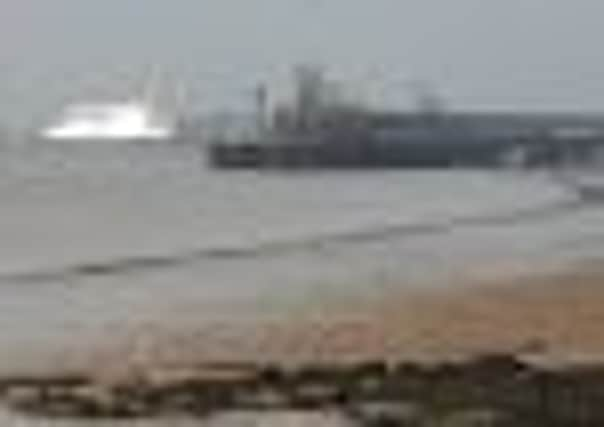Staking their place


I reckon there’s nothing more invigorating than a windy winter walk by water, and as I stroll beside the Humber this chilly Thursday you can tell that I’m fully invigorated by my exuberant prose and enthusiastic sentences.
The sun is fighting its way through the clouds, lighting up the mud-flats and a pair of horses passing on the low, close horizon. I’m trying to write notes like a good travel writer should but my hands are too cold and later, on the train back to Doncaster, I’ll hardly be able to decipher my scribbling. The words will look like runes and hieroglyphs, or more like runes and hieroglyphs than usual.
Advertisement
Hide AdAdvertisement
Hide AdI’m in Paull, a small village near Hull that seems, perhaps because of the sharp breeze making my eyes run, to be brimming with a kind of indefinable mystery and magic to do with a juxtaposition of ancient and modern, with industrial works dominating the landscape in one direction and seabirds swooping low over gravestones in the other.
It feels like a place where stories might grow, where legends might take root and prosper. Lots of people from Hull and the surrounding towns visit Paull in the summer, but I think it looks really majestic in its New Year winter plumage.
The best place to start in Paull is by the church, on a hill (or what passes for a hill in these parts) overlooking the water and fertile farmland and places like Thorngumbald. I rest a while on Bernard and Margaret Fraser-Varley’s bench in the churchyard, because their little plaque invites me to rest a while, so I do.
The church of St Andrew is older than it looks, parts of it dating from 1355; it was damaged by shots fired from Royalist boats on the Humber when Hull was besieged in the Civil War, and there’s a single bell in the tower from a foundry in Cumbria. I like the fact that, as far as I can tell, it seems to be called St Andrew rather than St Andrew’s because Paull is the kind of place that wants to do things its own way.
Advertisement
Hide AdAdvertisement
Hide AdChurches called St Andrew’s are 10 a penny but churches called St Andrew are as a rare as stone lecterns. St Andrew has a stone lectern, of course. And the village is called Paull with two lls. How cool is that, as my grandson would say. It would have been easier to call it Paul, but they’re too individualistic round these parts. I know the name really comes from the word Paghill meaning “a stake marking a landing place”. But they could still have called it Paul with one ‘l’ and they didn’t.
From the church I walk up the road and turn right into the biting teeth of the wind to wander by the Humber. As the clouds carry on slipping away, lots of well-wrapped fishermen grimace into the air as they wrestle with wind-shifting poles or just stand stoically watching them, hoping that something will happen; they represent the last, leisured, remnants of a fishing industry once based on shrimping and the catching of eels.
Paull was also a centre of shipbuilding and repair and there’s one small yard left, which was busy and clanking as I wandered by later on, on my way to find something to eat.
Up on Paull Holme Strays, an area of reclaimed land that’s now a mudflat and saltmarsh, I stand gazing out at the huge white P&O ferry that gleams in the winter sun, and walk up to the shore, by the two small disused (but listed) Thorngumbald Clough Lighthouses.
Advertisement
Hide AdAdvertisement
Hide AdBy this time my eyes are streaming in the chill and I can’t write anything in my notebook with my frozen hands so I turn back to the village, past the entrance to Fort Paull.
I guess the main thing that Paull’s known for these days is Fort Paull. As their publicity tells you, it’s Yorkshire’s Only Remaining Napoleonic Fortress. One of the museum’s most impressive exhibits is the last Blackburn Beverley aircraft, built nearby in Brough.
The Blackburn Beverley is a transport aircraft that was flown by the RAF in the 50s and 60s. Only 49 were ever made, and it’s mighty impressive that the one survivor is here, part of the web of surprise that Paull is made up of.
Fort Paull shuts for the winter so it’s closed. But when it reopens in the spring I’ll be there.
Advertisement
Hide AdAdvertisement
Hide AdI make my way down from the church to Paull’s main street, waiting and smiling as the horses pass. There used to be a lighthouse in Paull before they built the Thorngumbald Clough ones, but the building is still there. It’s now a private house, and there must be something amazing about living in a lighthouse, even if the light doesn’t work any more.
The village hall is well used, and there are plans in the window for a new one, and I hope they get it because this feels like the kind of place that honours the past but gets excited by the future.
Time for a sit down in the Royal Oak, one of three pubs in Paull, but the first one whose door I try. I have a nice cup of tea to unfreeze my mouth and I eat a lovely steak and ale pie with fat chips. I know I shouldn’t but, hey, I’ve been walking for ages.
In the next room a man says to his mate: “Well, she didn’t know I was only trying to take her wellies off!” That’s Paull for you: a story, a mystery wrapped in an enigma. With fat chips and lots of lighthouses. Maybe I’ll change my name to Iann.